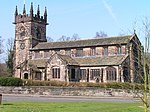Wilmslow Urban District
Cheshire geography stubsDistricts of England abolished by the Local Government Act 1972Districts of England created by the Local Government Act 1894Former districts of CheshireHistory of Cheshire ... and 2 more
Urban districts of EnglandWilmslow

Wilmslow Urban District is a former urban district in Cheshire, based in the town of Wilmslow. It was created in 1894 and abolished in 1974 when it was incorporated into the Borough of Macclesfield, which was itself abolished in 2009.
Excerpt from the Wikipedia article Wilmslow Urban District (License: CC BY-SA 3.0, Authors, Images).Wilmslow Urban District
Hawthorn Street,
Geographical coordinates (GPS) Address Nearby Places Show on map
Geographical coordinates (GPS)
| Latitude | Longitude |
|---|---|
| N 53.325 ° | E -2.239 ° |
Address
Print It
Hawthorn Street 10
SK9 5HZ , Fulshaw Park
England, United Kingdom
Open on Google Maps









